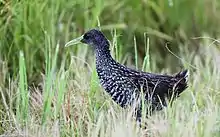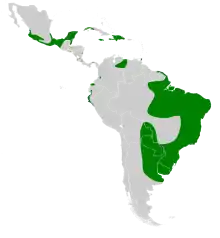Spotted rail
The spotted rail (Pardirallus maculatus) is a species of bird in the family Rallidae. It is found in Argentina, Belize, Bolivia, Brazil, Cayman Islands, Chile, Colombia, Costa Rica, Cuba, the Dominican Republic, Ecuador, El Salvador, French Guiana, Guyana, Jamaica, Mexico, Panama, Paraguay, Peru, Suriname, Trinidad and Tobago, Uruguay, Venezuela, and possibly Honduras. The spotted rail is found in marshland and swamps.
| Spotted rail | |
|---|---|
 | |
| Scientific classification | |
| Kingdom: | Animalia |
| Phylum: | Chordata |
| Class: | Aves |
| Order: | Gruiformes |
| Family: | Rallidae |
| Genus: | Pardirallus |
| Species: | P. maculatus |
| Binomial name | |
| Pardirallus maculatus (Boddaert, 1783) | |
 | |
Taxonomy
The spotted rail was described by the French polymath Georges-Louis Leclerc, Comte de Buffon in 1781 in his Histoire Naturelle des Oiseaux from a specimen collected in French Guiana.[2] The bird was also illustrated in a hand-coloured plate engraved by François-Nicolas Martinet in the Planches Enluminées D'Histoire Naturelle which was produced under the supervision of Edme-Louis Daubenton to accompany Buffon's text.[3] Neither the plate caption nor Buffon's description included a scientific name but in 1783 the Dutch naturalist Pieter Boddaert coined the binomial name Rallus maculatus in his catalogue of the Planches Enluminées.[4] The spotted rail is now placed in the genus Pardirallus that was erected by the French naturalist Charles Lucien Bonaparte in 1856.[5][6] The generic name combines the Ancient Greek pardos meaning "leopard" with the genus Rallus. The specific epithet maculatus is Latin for "spotted" or "blotched"[7]
Two subspecies are recognised:[6]
References
- BirdLife International (2012). "Pardirallus maculatus". IUCN Red List of Threatened Species. 2012. Retrieved 26 November 2013.CS1 maint: ref=harv (link)
- Buffon, Georges-Louis Leclerc de (1781). "Le râle tacheté de Cayenne". Histoire Naturelle des Oiseaux (in French). Volume 15. Paris: De L'Imprimerie Royale. p. 255.
- Buffon, Georges-Louis Leclerc de; Martinet, François-Nicolas; Daubenton, Edme-Louis; Daubenton, Louis-Jean-Marie (1765–1783). "Râle tacheté, de Cayenne". Planches Enluminées D'Histoire Naturelle. Volume 8. Paris: De L'Imprimerie Royale. Plate 775.
- Boddaert, Pieter (1783). Table des planches enluminéez d'histoire naturelle de M. D'Aubenton : avec les denominations de M.M. de Buffon, Brisson, Edwards, Linnaeus et Latham, precedé d'une notice des principaux ouvrages zoologiques enluminés (in French). Utrecht. p. 48, Number 775.
- Bonaparte, Charles Lucien (1856). "Excusion dans les divers Musées d'Allemagne, de Hollande et de Belgique (suite)". Comptes Rendus Hebdomadaires des Séances de l'Académie des Sciences. 43: 593–601 [599].
- Gill, Frank; Donsker, David, eds. (2019). "Flufftails, finfoots, rails, trumpeters, cranes, limpkin". World Bird List Version 9.2. International Ornithologists' Union. Retrieved 18 July 2019.
- Jobling, James A. (2010). The Helm Dictionary of Scientific Bird Names. London: Christopher Helm. pp. 236, 292. ISBN 978-1-4081-2501-4.

